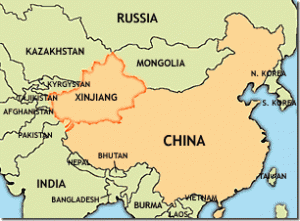Xinjiang Riots: A Primer – Part I

Map of China highlighting Xinjiang
On July 5, 2009, Urumqi, the western most provincial capital in China erupted into violence that continues to today. Xinjiang province, an area of China that very few people outside of China have ever heard of, is now front page news in most Western newspapers. While the press has reported admirably about a very confusing situation, below, in the first blog post of two, is some background on Xinjiang province, the Uighurs who live there, and the immediate cause of the riots.
Who are the Uighurs?
The Uighurs (also spelt Uyghers and pronounced “wee-gerz”) are a Turkic ethnic group that largely live in the Chinese province of Xinjiang. The Uighurs speak their own language, a language that is completely unrelated to Mandarin or any other Chinese dialect. Most Uighurs are Sunni Muslims. While ethnically the Uighurs are different from the Han Chinese (the dominant ethnic group in China), the Uighurs in Xinjiang province are Chinese citizens and under the Chinese constitution, enjoy the same rights and privileges as the Han Chinese. In fact, the Uighurs, because of their status as a minority group under Chinese law, receive certain privileges: they are not subject to China’s one-child policy and are often given preferential treatment for college admissions.
While Xinjiang province has been inhabited by western Eurasians for close to 4,000 years, most foreign scholars agree that the Uighurs migrated from present-day Mongolia to Xinjiang during the 10th century. During that time, the cities of Xinjiang, including Kashgar and Urumqi, were important stops on the Silk Road. China did not bring Xinjiang under full control until around 1760, but since then, Xinjiang has been a part of China. For a more detailed article on Xinjiang see “Rumbles on the Rim of China’s Empire” in the NY Times.
What sparked these riots?
The immediate cause of the protest and ensuing riots is not found in Urumqi or even Xinjiang province for that matter. Instead it is necessary to look to Shaoguan, a small factory town in the southeast province of Guangdong and more than 2,500 miles from Urumqi. Jonathan Watts of The Guardian has done the most extensive reporting in English on what occurred in Shaoguan and his article is a must read. In sum, because of the many factories in the city and surrounding areas, Shaoguan is home to a large number of China’s migrant workers who are employed by the factories. While most of the migrant workers are Han Chinese escaping poverty in the rural areas of China, one toy factory in Shaoguan, encouraged by a government program, hired over 800 Uighur migrants from Xinjiang this past May. Relations between the Han and Uighur workers began to deteriorate rapidly after rumors began to spread amongst the Han Chinese in the factory that Uighur workers raped two Han Chinese women. On June 25, some of the Han workers took out their anger and attacked the Uighurs in the toy factory. By the end of the night, two Uighurs were dead and many more injured. Mr. Watts reports that a participant in the beatings believes that many more than two Uighurs were killed in Shaoguan; potentially as many as 30. However, this man’s account could not be corroborated.
Through text messaging and the internet, the Uighurs from the toy factory informed their friends and relatives back in Xinjiang of the murders. In response, a peaceful protest in Urumqi was organized for July 5. Drawing over a thousand Uighurs, the crowd quickly got out of hand and violence against the Han Chinese in Urumqi ensued. In the following days, the Han Chinese responded in kind against the Uighurs. Today, 184 people are reported dead (although some foreign media outlets put the death toll higher) and violence from both sides continues, with the police unsuccessful in attempting to quell the situation.
Click here for Part II.
 On Facebook
On Facebook By Email
By Email 
Dear Elizabeth,
Thank you so much for this summary on Xinjiang. May I use the map of Xinjiang for an academic report I am writing for my university studies? I will cite your map as well as this website!
[…] (1) Public trials can ease foreign criticism. The international press, including papers in the U.S., Europe and the Middle East, followed the Xinjiang riots closely and will be publicizing the verdicts of the trials. But if the trials remain closed, the press is left with nothing but rumors from inside the courtroom. Rumors are what started the riots in the first place (see previous post). […]